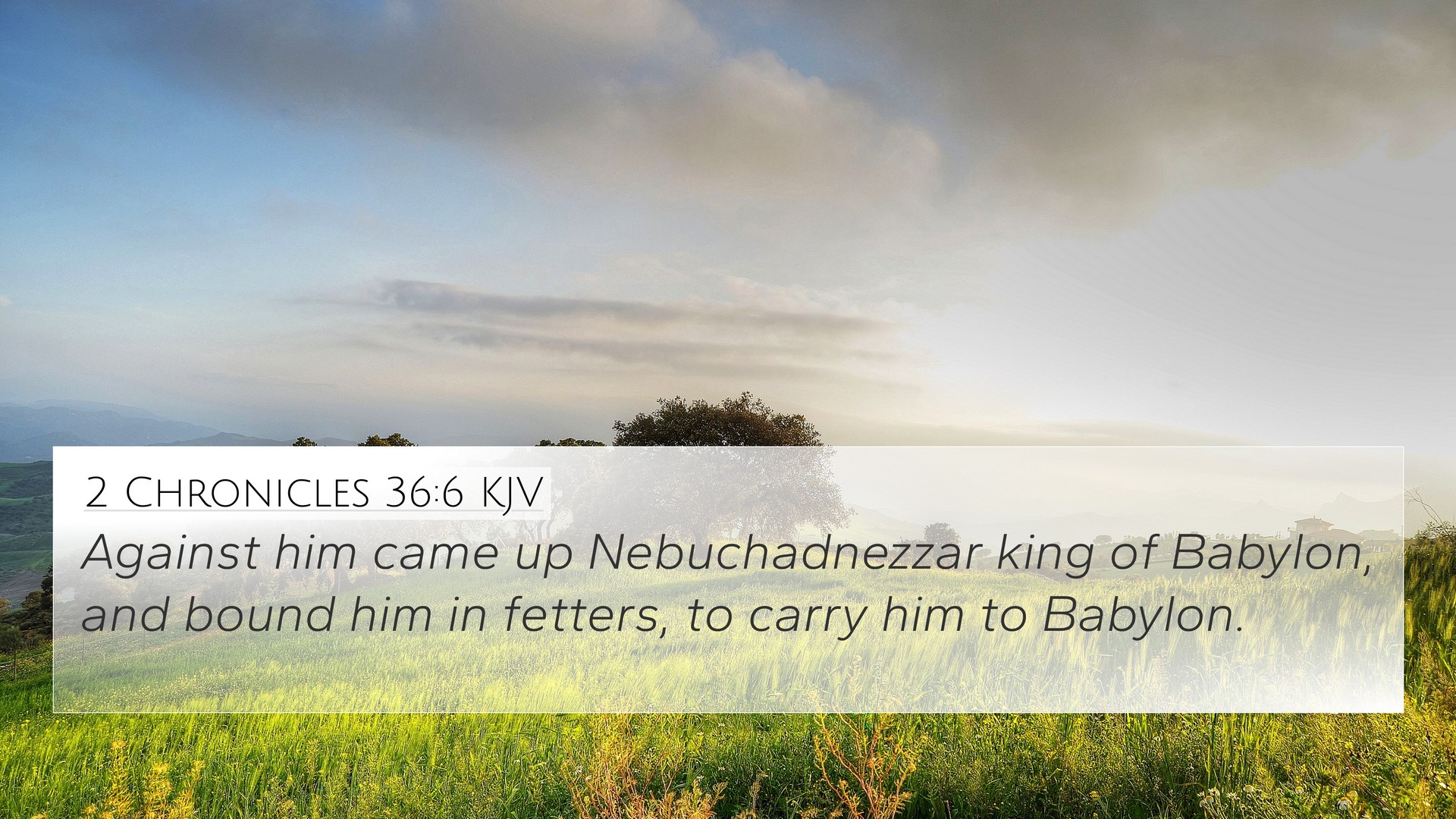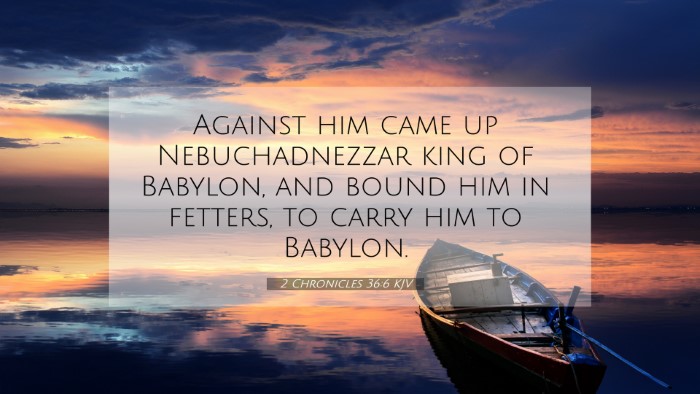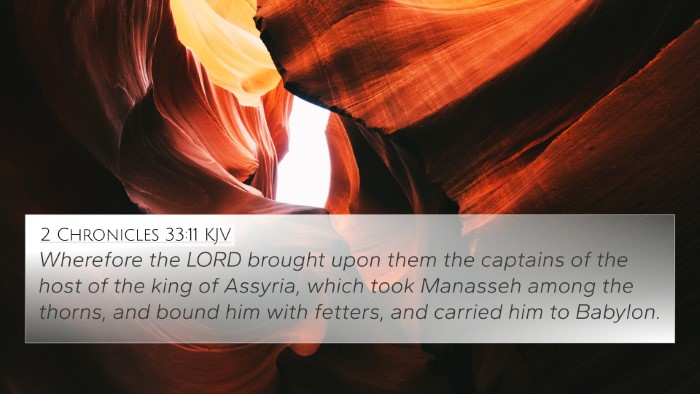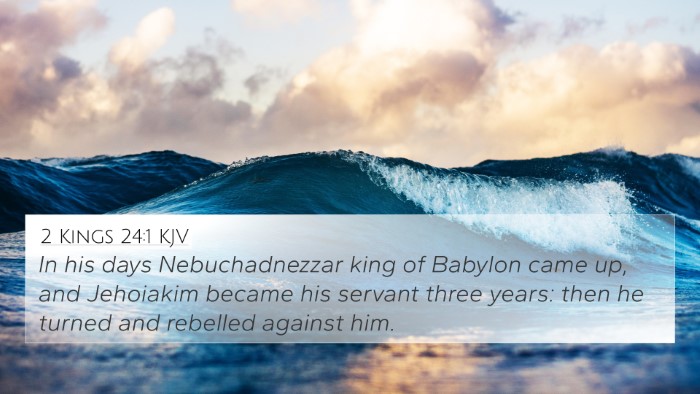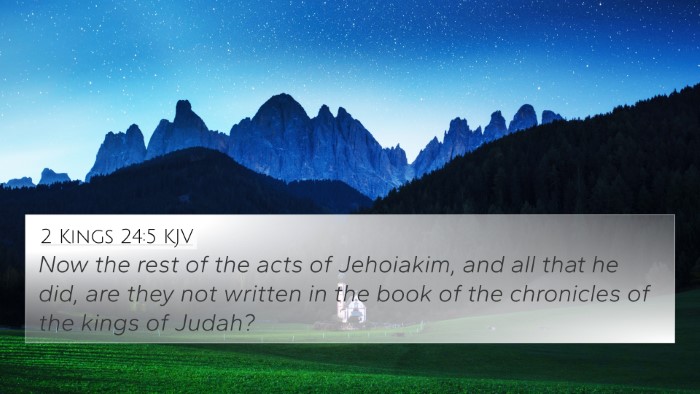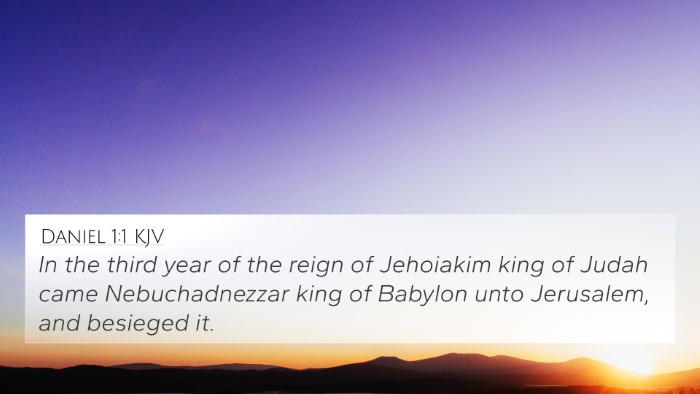Understanding 2 Chronicles 36:6
Verse: "Against him came up Nebuchadnezzar king of Babylon, and bound him in fetters, to carry him to Babylon."
Summary of 2 Chronicles 36:6
This verse depicts a critical moment in the history of Judah, emphasizing divine judgment through the Babylonian conquest. King Jehoiakim of Judah is taken captive by Nebuchadnezzar, illustrating the consequences of Israel’s disobedience to God.
Commentary Insights
-
Matthew Henry (Commentary on the Whole Bible):
Henry notes that Jehoiakim's captivity serves as a reminder of God's judgment upon a nation that turns away from Him. His capture and subsequent binding symbolize the loss of freedom due to sin and rebellion against God’s commandments.
-
Albert Barnes (Barnes' Notes on the Bible):
Barnes highlights the historical significance of Nebuchadnezzar's role as an instrument of God's wrath. The verse indicates not only a physical captivity but also a spiritual one, where the people of Judah faced the consequences of their continued idolatry and disrespect towards God's law.
-
Adam Clarke (Clarke's Commentary on the Holy Scriptures):
Clarke points out that the binding of Jehoiakim was a significant act, as it marked the beginning of the end for the kingdom of Judah. He discusses how this event resonates with the broader theme of divine sovereignty and the prophetic warnings that had previously gone unheeded.
Thematic Bible Verse Connections
2 Chronicles 36:6 can be linked to various themes and related scriptures, which offer additional insight into its meaning. Below are some notable cross-references:
- Jeremiah 22:25: “And I will give thee into the hand of them that seek thy life…” - Refers to Jehoiakim’s fate as a consequence of his actions.
- Ezekiel 21:25-27: Discusses the fall of the house of Judah and God's judgment, further emphasizing the themes in 2 Chronicles.
- 2 Kings 24:1: Details the actions of Nebuchadnezzar and the initial siege against Judah, setting the stage for Jehoiakim's capture.
- Daniel 1:1-2: Chronicles the Babylonian conquest of Jerusalem, highlighting the fulfillment of prophetic judgments.
- Isaiah 39:6-7: Prophetic words regarding the captivity, illustrating the consequences of Israel's actions.
- Zechariah 1:12: Reflects God's concern over Jerusalem and the longer-term consequences of the sins of its leaders.
- Lamentations 1:1: Expresses the sorrow and lament following the destruction of Jerusalem, connecting to the events of this verse.
- Matthew 24:2: Jesus references the destruction of the temple, evoking historical precedents found in events like those in 2 Chronicles.
- Romans 1:18-32: Discusses the wrath of God against unrighteousness, echoing the themes of judgment as seen in 2 Chronicles.
- Hebrews 12:6: “For whom the Lord loveth he chasteneth…” - A reminder that discipline from God is often a corrective measure for His people.
Connections Between Bible Verses
The narrative of Jehoiakim's captivity and the themes surrounding it resonate with broader scriptural themes of sin, judgment, restoration, and divine sovereignty. Understanding this verse in light of interconnected passages can provide profound insight into God's interactions with His people.
Comparative Bible Verse Analysis
By exploring related verses and themes, believers can gain a deeper understanding of God's character and His expectations. The cross-referencing of scriptures serves as a vital tool for studying the Bible, revealing layers of meaning and consistency across the text.
Tools for Bible Cross-Referencing
Utilizing resources such as a bible concordance or a bible cross-reference guide can greatly enhance one’s study of interconnected verses. These tools allow individuals to identify connections and enhance their scriptural understanding through thematic explorations.
Conclusion
The exploration of 2 Chronicles 36:6 exemplifies the critical nature of understanding scripture within its historical and theological context. Through careful study and cross-referencing, readers can uncover the richness of biblical truths and their implications for faith and living.
